The peptide based nanomaterials market is estimated to be valued at USD 4.9 billion in 2025 and is projected to reach USD 12.2 billion by 2035, registering a compound annual growth rate (CAGR) of 9.5% over the forecast period.
From 2025 to 2030, the market is expected to expand steadily from USD 4.9 billion to USD 7.1 billion, driven primarily by rising research investments in biomedicine, targeted drug delivery, and regenerative medicine. Innovations in self-assembling peptide structures, functionalized nanocarriers, and peptide-based hydrogels are anticipated to accelerate applications across oncology, tissue engineering, and vaccine delivery. Academic-industry collaborations and government-backed research grants are expected to further propel early-stage development.
From 2030 to 2035, the market is projected to grow from USD 7.1 billion to USD 12.2 billion, fueled by commercial adoption in pharmaceuticals, diagnostics, and cosmetic applications. The increasing integration of peptide nanomaterials in biosensors, antimicrobial coatings, and advanced therapeutics is likely to create new commercial opportunities. Market expansion is also supported by rising patent filings, strategic partnerships between biotechnology firms, and growing awareness of the efficacy of peptide-based nanomaterials in precision medicine. Regional adoption trends suggest North America and Europe will lead due to strong R&D infrastructure, while Asia-Pacific is anticipated to experience rapid uptake driven by emerging biotech hubs and government support programs. Overall, the market is expected to witness sustained momentum, with incremental growth fueled by technological exploration, clinical validation, and expanding industrial applications.
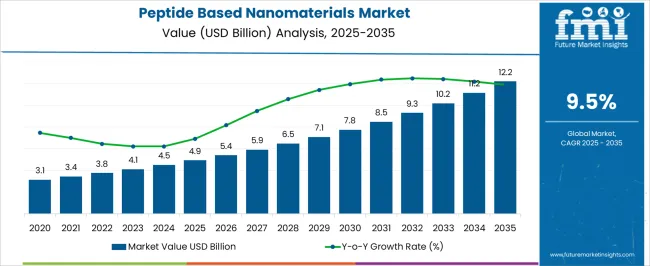
| Metric | Value |
|---|---|
| Peptide Based Nanomaterials Market Estimated Value in (2025 E) | USD 4.9 billion |
| Peptide Based Nanomaterials Market Forecast Value in (2035 F) | USD 12.2 billion |
| Forecast CAGR (2025 to 2035) | 9.5% |
The peptide-based nanomaterials market is strongly influenced by five interconnected parent markets that collectively drive research adoption, therapeutic applications, and commercial development. The pharmaceutical and biotechnology market holds the largest share at 35%, as peptide nanomaterials are increasingly applied in targeted drug delivery, oncology therapeutics, and vaccine formulations, ensuring higher efficacy and reduced side effects. The medical devices and diagnostics market contributes 25%, with nanomaterial-enabled biosensors, imaging agents, and diagnostic kits forming the backbone of advanced patient monitoring and early disease detection. The tissue engineering and regenerative medicine sector accounts for 15%, representing demand for peptide hydrogels, scaffolds, and self-assembling nanostructures that support cellular growth, repair, and functional tissue reconstruction.
The cosmetics and personal care market, with a 12% share, leverages peptide-based nanomaterials for anti-aging, skin repair, and targeted delivery of active ingredients, enhancing product performance and consumer appeal. Finally, the research and academic market contributes 13%, driven by experimental studies, material optimization, and preclinical validation of peptide nanostructures for multiple biomedical applications. Combined, the pharmaceutical and biotechnology and medical device markets account for 60% of overall demand, highlighting that therapeutic applications and diagnostic solutions remain the primary growth drivers for the peptide-based nanomaterials market.
The peptide based nanomaterials market is witnessing rapid development driven by advancements in nanotechnology, biocompatible material research, and precision medicine applications. Growing interest in peptides as versatile building blocks for nanostructures is supported by their ability to self assemble into functional architectures with high specificity and stability.
Pharmaceutical and biotechnology sectors are increasingly leveraging these materials for targeted drug delivery, regenerative medicine, and diagnostic applications. Ongoing research into tunable peptide sequences is enabling customization for specific therapeutic goals, while improvements in manufacturing scalability are supporting commercial viability.
Regulatory encouragement for biodegradable and low toxicity nanomaterials is further accelerating adoption. The market outlook remains strong as continued innovation in peptide engineering and clinical translation drives broader integration across healthcare and life sciences.
The peptide based nanomaterials market is segmented by type, nanostructure morphology, application, end use industry, and geographic regions. By type, peptide based nanomaterials market is divided into self-assembling peptides, peptide amphiphiles, peptide polymer conjugates, peptide nanoparticle hybrids, cyclic peptide nanostructures, and others. In terms of nanostructure morphology, peptide based nanomaterials market is classified into nanofibers & nanotubes, nanospheres & vesicles, hydrogels & scaffolds, nanoparticles, 2d nanosheets & films, and others. Based on application, peptide based nanomaterials market is segmented into drug delivery, tissue engineering & regenerative medicine, biosensing & diagnostics, antimicrobial applications, bioimaging & theranostics, and other applications. By end use industry, peptide based nanomaterials market is segmented into pharmaceutical & biotechnology, healthcare & medical devices, research & academic institutions, cosmetics & personal care, food & agriculture, and others. Regionally, the peptide based nanomaterials industry is classified into North America, Latin America, Western Europe, Eastern Europe, Balkan & Baltic Countries, Russia & Belarus, Central Asia, East Asia, South Asia & Pacific, and the Middle East & Africa.
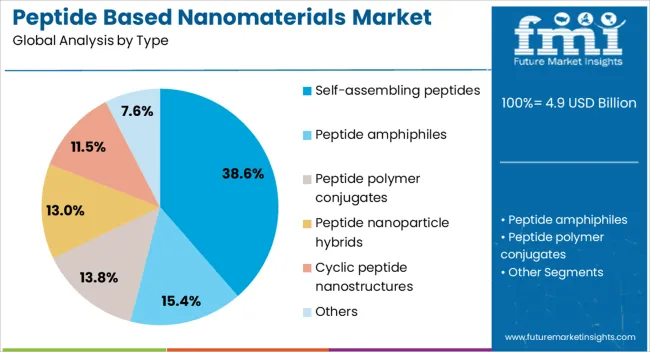
The self assembling peptides segment is expected to account for 38.60% of total market revenue by 2025 within the type category, making it the leading segment. This dominance is driven by their inherent ability to form stable and functional nanostructures without external templating, enabling diverse biomedical and nanotechnological applications.
Their structural versatility allows precise control over size, shape, and surface properties, which is critical for targeted therapeutic delivery and tissue engineering. Additionally, self assembling peptides demonstrate high biocompatibility and biodegradability, aligning with regulatory and environmental standards.
The combination of functional adaptability, ease of synthesis, and tunability has positioned this type as a preferred choice for research and commercial use.
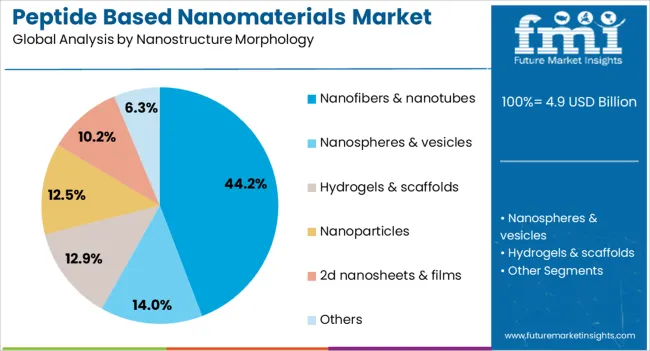
The nanofibers and nanotubes segment is projected to hold 44.20% of total market revenue by 2025 in the nanostructure morphology category, establishing itself as the dominant form. This is attributed to their high surface area to volume ratio, mechanical strength, and ability to mimic natural extracellular matrix structures.
These properties enhance cell adhesion, proliferation, and differentiation, making them highly suitable for biomedical applications including scaffolding and regenerative medicine. In drug delivery, their elongated structure facilitates controlled release and targeted delivery efficiency.
The segment’s growth is reinforced by ongoing innovations in fabrication methods and functionalization strategies that expand their utility across pharmaceutical and nanotechnology sectors.
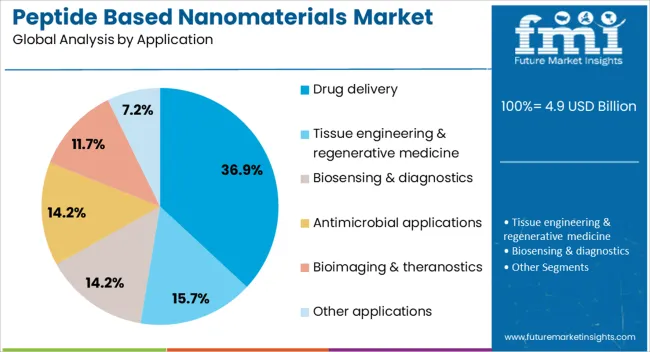
The drug delivery segment is anticipated to represent 36.90% of total market revenue by 2025 within the application category, securing its position as the leading application area. This growth is driven by the ability of peptide based nanomaterials to provide precise, targeted, and sustained release of therapeutic agents.
Their customizable surface chemistry and tunable degradation rates allow for optimization based on drug type and delivery route. Reduced systemic toxicity and improved bioavailability have strengthened their adoption in oncology, infectious diseases, and chronic condition management.
Ongoing clinical trials and increasing investment in nanomedicine platforms are further expanding the scope of drug delivery applications, consolidating this segment’s market leadership.
Peptide-based nanomaterials are driving growth across therapeutics, diagnostics, tissue engineering, and cosmetics. Targeted delivery, regenerative medicine, and biosensing applications remain key adoption drivers globally.
The peptide-based nanomaterials market is witnessing strong growth due to their unique ability to enable targeted drug delivery. Peptide nanocarriers are increasingly used to transport chemotherapeutics directly to tumor cells, minimizing systemic toxicity and improving treatment outcomes. Researchers are focusing on optimizing peptide sequences, self-assembling properties, and surface functionalization to enhance cellular uptake and circulation time. Applications in oncology, infectious diseases, and chronic disorders are accelerating adoption, while collaborations between biotech firms and pharmaceutical companies are fostering clinical translation. Regulatory approvals and ongoing clinical trials further support market expansion. The growing demand for precision medicine, combined with increasing investments in nanomedicine research, is expected to drive sustained adoption of peptide-based nanomaterials across therapeutic areas.
Peptide-based nanomaterials are being integrated into tissue engineering and regenerative medicine applications due to their biocompatibility, structural versatility, and ability to mimic extracellular matrices. Hydrogels, scaffolds, and self-assembling peptide fibers are increasingly used for wound healing, cartilage regeneration, and organoid development. Academic institutions and research organizations are actively investigating the mechanical and biochemical properties of peptide nanomaterials to improve cellular adhesion, differentiation, and proliferation. Partnerships between material scientists and biomedical companies are promoting commercialization for preclinical and clinical applications. Regulatory guidance on biocompatibility and safety testing is shaping product design. As regenerative therapies gain traction, demand for peptide-based scaffolds and engineered nanostructures is expected to expand globally.
The peptide-based nanomaterials market is also expanding in diagnostics and biosensing, driven by the need for high-sensitivity detection systems. Peptide nanostructures are applied in biosensors, imaging agents, and lab-on-chip devices to detect biomarkers with high specificity. Hospitals, research laboratories, and diagnostic companies are adopting these materials for early disease detection, including cancer, infectious diseases, and metabolic disorders. Integration with microfluidics, fluorescence tagging, and electrochemical sensing enables rapid, accurate, and point-of-care diagnostics. Strategic collaborations between startups and established diagnostics firms are accelerating commercialization. The increased focus on personalized medicine and predictive healthcare is driving investments in peptide-based nanomaterial-enabled diagnostic platforms.
Peptide-based nanomaterials are increasingly applied in cosmetics and personal care products due to their ability to deliver active ingredients efficiently to targeted skin layers. Anti-aging, skin repair, and hydration formulations are benefiting from peptide encapsulation, which enhances stability and bioavailability. Companies are exploring novel peptide sequences for wrinkle reduction, collagen stimulation, and pigmentation control. Product differentiation through peptide technology is being leveraged in premium skincare, haircare, and dermatological lines. Marketing campaigns emphasize scientific efficacy, safety, and visible results to attract health-conscious consumers. The combination of R&D efforts and consumer demand for advanced cosmetic solutions is expected to expand market penetration and adoption of peptide-based nanomaterials in personal care globally.
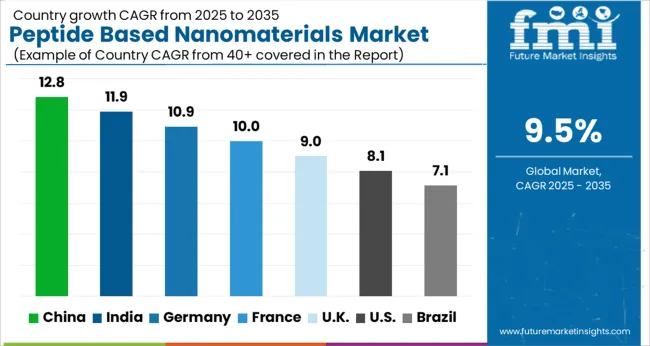
| Country | CAGR |
|---|---|
| China | 12.8% |
| India | 11.9% |
| Germany | 10.9% |
| France | 10.0% |
| UK | 9.0% |
| USA | 8.1% |
| Brazil | 7.1% |
The global peptide-based nanomaterials market is projected to grow at a CAGR of 9.5% from 2025 to 2035. China leads with 12.8%, followed by India at 11.9%, France at 10.0%, the UK at 9.0%, and the USA at 8.1%. Growth is fueled by rising R&D investments, adoption in therapeutics, diagnostics, and regenerative medicine, and expanding clinical applications. BRICS countries, particularly China and India, are accelerating commercialization through biotech innovation, government research funding, and local manufacturing capabilities, while OECD nations emphasize precision medicine, high-sensitivity biosensing, and regulatory compliance. Strong demand exists for peptide nanocarriers, hydrogels, scaffolds, and biosensors across pharmaceutical, medical, and cosmetic sectors. The analysis includes over 40+ countries, with the leading markets detailed below.
The peptide-based nanomaterials market in China is projected to grow at a CAGR of 12.8% from 2025 to 2035, driven by heavy investment in biotech research, pharmaceutical manufacturing, and clinical translation of nanomedicine. Hospitals, research institutes, and biotech firms are adopting peptide nanocarriers, self-assembling hydrogels, and scaffolds for targeted drug delivery, tissue engineering, and regenerative medicine. Collaborations between domestic startups and multinational pharmaceutical companies are accelerating commercialization. Government funding for precision medicine, peptide therapeutics, and biosensing platforms further expands opportunities. China’s strong manufacturing base supports large-scale production of high-purity peptides and nanomaterials, ensuring rapid supply for therapeutic, diagnostic, and cosmetic applications.
India’s peptide-based nanomaterials market is expected to grow at a CAGR of 11.9% from 2025 to 2035, fueled by expanding pharmaceutical R&D, contract research services, and biosensor development. Academic institutions and private biotech firms are increasingly leveraging peptide nanostructures for drug delivery, diagnostics, and tissue engineering applications. Government programs supporting innovation in biotechnology, along with startup incubators and public-private partnerships, promote commercialization of peptide-based solutions. Growing adoption in healthcare, regenerative medicine, and cosmetics is increasing demand for scalable production and high-quality materials. Collaborations with global pharmaceutical players ensure technology transfer, knowledge sharing, and accelerated development of novel peptide-based therapeutics and nanomaterials.
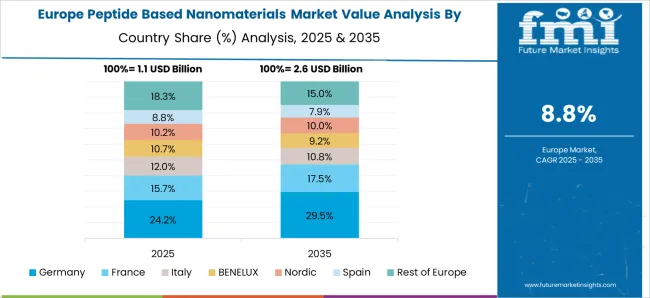
The peptide-based nanomaterials market in France is projected to grow at a CAGR of 10.0% from 2025 to 2035, driven by research-intensive biotech firms and advanced clinical programs. French pharmaceutical companies and research hospitals are applying peptide nanostructures in targeted therapeutics, biosensing platforms, and regenerative medicine. Investment in laboratory infrastructure, pilot-scale manufacturing, and analytical capabilities supports innovation. Collaborations between startups and multinational corporations foster commercialization of high-purity peptides and self-assembling nanomaterials. Regulatory support and emphasis on precision medicine accelerate adoption. Cosmetic applications, including peptide-based skincare formulations, are contributing to market expansion, while academic and industrial partnerships ensure continuous pipeline development.
The UK peptide-based nanomaterials market is expected to grow at a CAGR of 9.0% from 2025 to 2035, led by advanced pharmaceutical research, biotech startups, and clinical translation initiatives. Universities and research hospitals are focusing on peptide-based drug delivery systems, biosensors, and tissue engineering scaffolds. Government-backed innovation grants, R&D tax credits, and life sciences strategies facilitate commercialization. Partnerships with global pharmaceutical companies enable technology transfer and collaborative development of peptide nanomaterials. Adoption is rising in therapeutic, diagnostic, and cosmetic segments, with emphasis on safety, biocompatibility, and regulatory compliance. UK-based manufacturers are investing in pilot-scale peptide synthesis and formulation capabilities to meet domestic and export demand.
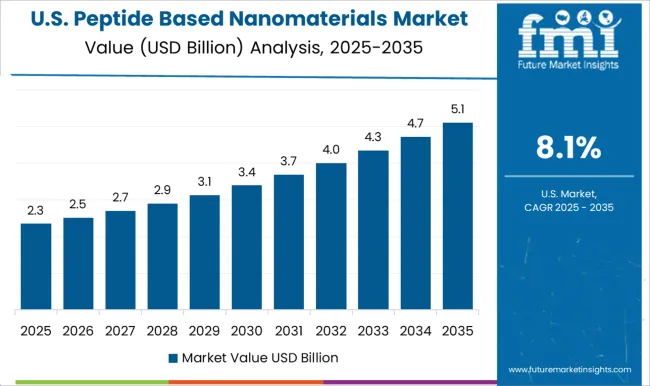
The USA peptide-based nanomaterials market is projected to grow at a CAGR of 8.1% from 2025 to 2035, supported by significant biotech R&D, pharmaceutical investment, and clinical adoption. Peptide nanocarriers, self-assembling scaffolds, and nanostructures are increasingly applied in oncology, infectious diseases, and regenerative therapies. Collaborations between research institutes and industry players accelerate product development and commercialization. High demand exists for diagnostic biosensors, therapeutic nanomaterials, and cosmetic formulations. Regulatory approvals, clinical trials, and government funding programs further support market expansion. USA-based manufacturers focus on high-quality peptide production, scale-up processes, and integration with advanced drug delivery systems, driving global competitiveness.

Competition in the peptide-based nanomaterials market is shaped by precision synthesis, biocompatibility, and scalability for therapeutic, diagnostic, and regenerative applications. Ferring Pharmaceuticals and 3D Matrix Medical Technology lead with advanced peptide therapeutics, drug delivery platforms, and clinical-stage nanomedicine programs. Nanovesicular (NVS) Technologies and CellMark Medical focus on targeted delivery systems, encapsulation technologies, and peptide-functionalized nanocarriers for oncology and regenerative medicine. Nanomatrix Therapeutics and Anika Therapeutics, Inc. differentiate with self-assembling hydrogels and scaffolds for tissue engineering and controlled release applications.
Nanoviricides, Inc. and Peptron, Inc. emphasize antiviral and peptide-drug conjugates, while Ambiopharm, Inc. and Bachem Holding AG support large-scale peptide synthesis and GMP manufacturing for global clients. PolyPeptide Group, Nanosphere Health Sciences, Inc., and Peptide Solutions, LLC specialize in custom peptide synthesis, high-purity compounds, and clinical supply services, enabling biotech and pharma collaborations. PeptiDream Inc. and Genscript Biotech Corporation leverage AI and combinatorial chemistry to accelerate novel peptide discovery and functionalization. Peptisyntha (Solvay Group), Pepscan, Nanopartz Inc., CPC Scientific Inc., and Advanced Peptides compete through niche offerings, such as peptide libraries, modified amino acids, and high-throughput synthesis for R&D and clinical pipelines.
Strategies across the market emphasize precision, modularity, and compliance with regulatory standards such as FDA, EMA, and GMP. Innovation in peptide nanocarriers, functionalization, and delivery platforms is marketed as a differentiation lever. Lifecycle support, analytical services, and collaborative R&D programs are promoted to enhance adoption and reduce time-to-market. Product brochures highlight peptide purity, molecular weight, functional modifications, nanocarrier compatibility, stability, and formulation guidelines, reflecting a market focused on high-quality, scalable, and clinically relevant peptide-based nanomaterials.
| Item | Value |
|---|---|
| Quantitative Units | USD 4.9 Billion |
| Type | Self-assembling peptides, Peptide amphiphiles, Peptide polymer conjugates, Peptide nanoparticle hybrids, Cyclic peptide nanostructures, and Others |
| Nanostructure Morphology | Nanofibers & nanotubes, Nanospheres & vesicles, Hydrogels & scaffolds, Nanoparticles, 2d nanosheets & films, and Others |
| Application | Drug delivery, Tissue engineering & regenerative medicine, Biosensing & diagnostics, Antimicrobial applications, Bioimaging & theranostics, and Other applications |
| End Use Industry | Pharmaceutical & biotechnology, Healthcare & medical devices, Research & academic institutions, Cosmetics & personal care, Food & agriculture, and Others |
| Regions Covered | North America, Europe, Asia-Pacific, Latin America, Middle East & Africa |
| Country Covered | United States, Canada, Germany, France, United Kingdom, China, Japan, India, Brazil, South Africa |
| Key Companies Profiled | Ferring Pharmaceuticals, 3D Matrix Medical Technology, Nanovesicular (NVS) Technologies, CellMark Medical, Nanomatrix Therapeutics, Anika Therapeutics, Inc., Nanoviricides, Inc., Peptron, Inc., Ambiopharm, Inc., Bachem Holding AG, PolyPeptide Group, Nanosphere Health Sciences, Inc., Peptide Solutions, LLC, PeptiDream Inc., Genscript Biotech Corporation, Peptisyntha (Solvay Group), Pepscan, Nanopartz Inc., CPC Scientific Inc., and Advanced Peptides |
| Additional Attributes | Dollar sales, market share by application (drug delivery, diagnostics, regenerative medicine), regional adoption trends, CAGR by segment, competitive landscape, key players’ production capacities, pricing strategies, and emerging regulatory frameworks. |
The global peptide based nanomaterials market is estimated to be valued at USD 4.9 billion in 2025.
The market size for the peptide based nanomaterials market is projected to reach USD 12.2 billion by 2035.
The peptide based nanomaterials market is expected to grow at a 9.5% CAGR between 2025 and 2035.
The key product types in peptide based nanomaterials market are self-assembling peptides, peptide amphiphiles, peptide polymer conjugates, peptide nanoparticle hybrids, cyclic peptide nanostructures and others.
In terms of nanostructure morphology, nanofibers & nanotubes segment to command 44.2% share in the peptide based nanomaterials market in 2025.






Our Research Products

The "Full Research Suite" delivers actionable market intel, deep dives on markets or technologies, so clients act faster, cut risk, and unlock growth.

The Leaderboard benchmarks and ranks top vendors, classifying them as Established Leaders, Leading Challengers, or Disruptors & Challengers.

Locates where complements amplify value and substitutes erode it, forecasting net impact by horizon

We deliver granular, decision-grade intel: market sizing, 5-year forecasts, pricing, adoption, usage, revenue, and operational KPIs—plus competitor tracking, regulation, and value chains—across 60 countries broadly.

Spot the shifts before they hit your P&L. We track inflection points, adoption curves, pricing moves, and ecosystem plays to show where demand is heading, why it is changing, and what to do next across high-growth markets and disruptive tech

Real-time reads of user behavior. We track shifting priorities, perceptions of today’s and next-gen services, and provider experience, then pace how fast tech moves from trial to adoption, blending buyer, consumer, and channel inputs with social signals (#WhySwitch, #UX).

Partner with our analyst team to build a custom report designed around your business priorities. From analysing market trends to assessing competitors or crafting bespoke datasets, we tailor insights to your needs.
Supplier Intelligence
Discovery & Profiling
Capacity & Footprint
Performance & Risk
Compliance & Governance
Commercial Readiness
Who Supplies Whom
Scorecards & Shortlists
Playbooks & Docs
Category Intelligence
Definition & Scope
Demand & Use Cases
Cost Drivers
Market Structure
Supply Chain Map
Trade & Policy
Operating Norms
Deliverables
Buyer Intelligence
Account Basics
Spend & Scope
Procurement Model
Vendor Requirements
Terms & Policies
Entry Strategy
Pain Points & Triggers
Outputs
Pricing Analysis
Benchmarks
Trends
Should-Cost
Indexation
Landed Cost
Commercial Terms
Deliverables
Brand Analysis
Positioning & Value Prop
Share & Presence
Customer Evidence
Go-to-Market
Digital & Reputation
Compliance & Trust
KPIs & Gaps
Outputs
Full Research Suite comprises of:
Market outlook & trends analysis
Interviews & case studies
Strategic recommendations
Vendor profiles & capabilities analysis
5-year forecasts
8 regions and 60+ country-level data splits
Market segment data splits
12 months of continuous data updates
DELIVERED AS:
PDF EXCEL ONLINE
Peptide-Infused Anti-Aging Serums Market Analysis - Size and Share Forecast Outlook 2025 to 2035
Peptide-Infused Tinted Moisturizers Market Size and Share Forecast Outlook 2025 to 2035
Peptide-Enhanced Firming Creams Market Analysis - Size and Share Forecast Outlook 2025 to 2035
Peptide Drug Conjugates Market Size and Share Forecast Outlook 2025 to 2035
Peptide Supplements Market Analysis - Size, Share, and Forecast Outlook 2025 to 2035
Peptide Receptor Radionuclide Therapy (PRRT) Market Trends and Forecast 2025 to 2035
Peptide Synthesis Market Analysis – Trends, Share & Growth 2025 to 2035
Key Players & Market Share in the Peptide Microarray Sector
Peptide Therapeutics Market Analysis - Growth & Forecast 2024 to 2034
Peptide Antibiotics Market
Peptide Microarrays Market
Peptide-based Sweetener Size and Share Forecast Outlook 2025 to 2035
Tuna Peptides Market – Growth, Demand & Functional Benefits
Plant Peptides Market Size and Share Forecast Outlook 2025 to 2035
Tetra-Peptide Anti-Wrinkle Solutions Market Analysis - Size, Share, and Forecast Outlook 2025 to 2035
Custom Peptide Synthesis Services Market Size and Share Forecast Outlook 2025 to 2035
Animal Peptides Market Size and Share Forecast Outlook 2025 to 2035
Marine Peptide Market Size and Share Forecast Outlook 2025 to 2035
Lupine Peptides Market Size and Share Forecast Outlook 2025 to 2035
Collagen Peptide Market Analysis - Size, Growth, and Forecast 2025 to 2035

Thank you!
You will receive an email from our Business Development Manager. Please be sure to check your SPAM/JUNK folder too.
Chat With
MaRIA